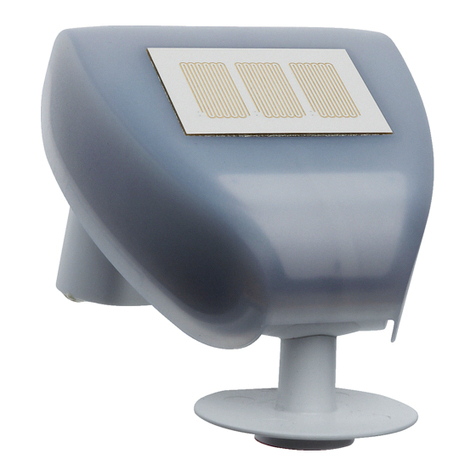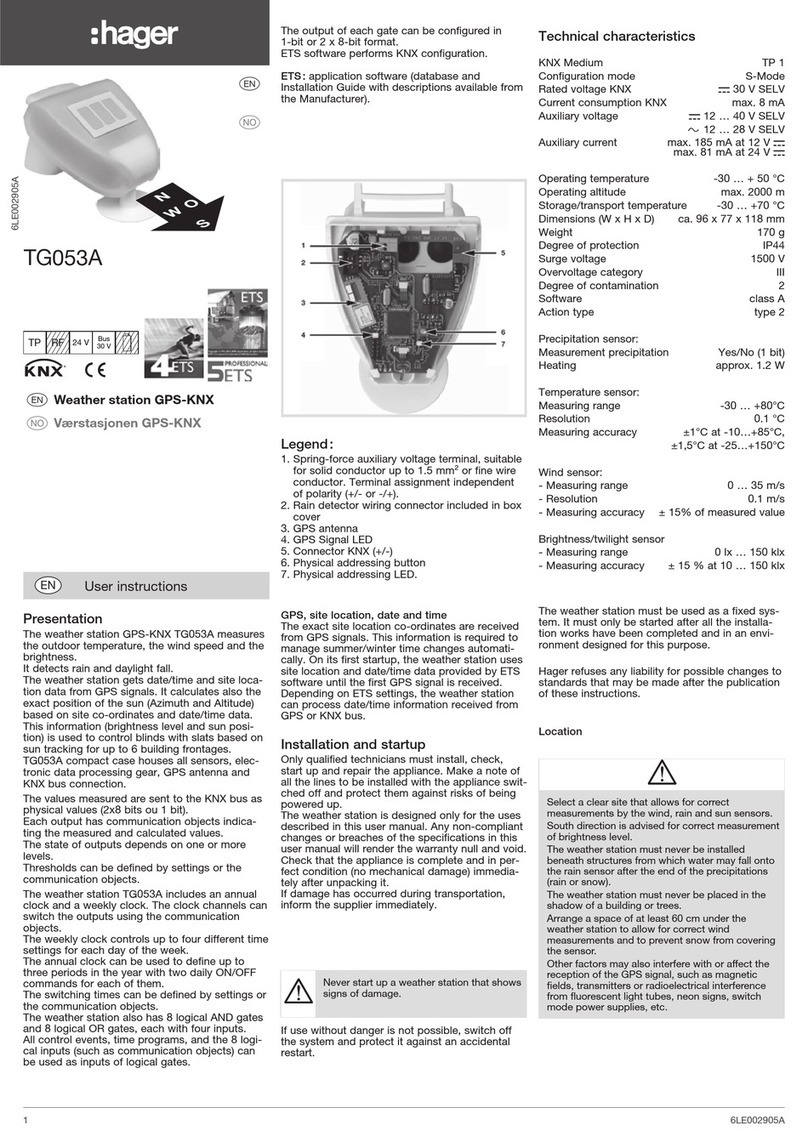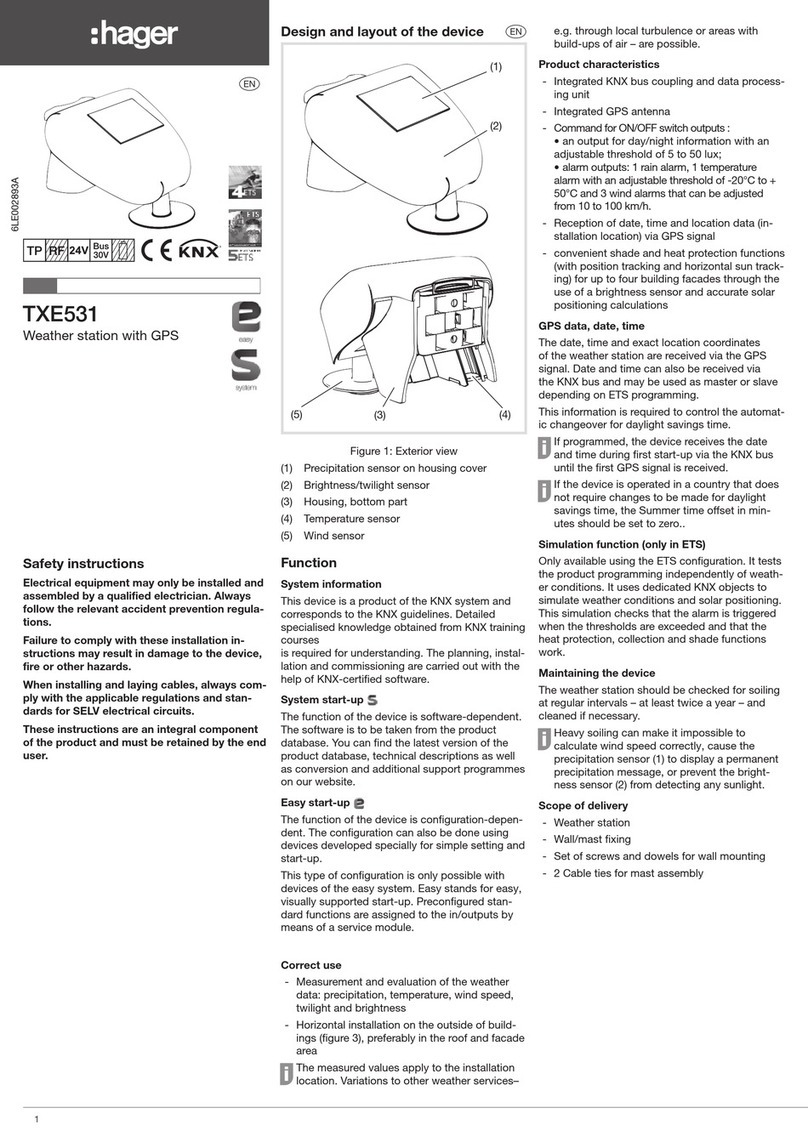hager TXE530 User manual

TXE530 1 6LE001714A
application software
KNX GPS Weather station
Electrical/Mechanical characteristics: see product user manual
Product reference Product designation Application software
ref
TP device
Radio device
TXE530 KNX GPS Weather station STXE530
1.x Version
A fair e

TXE530 2 6LE001714A
1. General ............................................................................................................................................................................. 3
1.1 About this guide........................................................................................................................................................... 3
1.2 About the program ETS............................................................................................................................................... 3
1.2.1 ETS compatibility .................................................................................................................................................. 3
1.2.2 Application descriptions ........................................................................................................................................ 3
1.3 Easy tool software appearance ................................................................................................................................... 3
2. General Description .......................................................................................................................................................... 4
2.1 Installation of the device .............................................................................................................................................. 4
2.1.1 Overview presentation .......................................................................................................................................... 4
2.1.2 Connection ............................................................................................................................................................ 5
2.1.3 Physical addressing .............................................................................................................................................. 5
2.1.4 Status of the station in the event of a power failure and re-start........................................................................... 6
2.2 Function modules of the application ............................................................................................................................ 7
3. Programming by ETS........................................................................................................................................................ 9
3.1 Parameters .................................................................................................................................................................. 9
3.1.1 General ................................................................................................................................................................. 9
3.1.1.1 Date and time ................................................................................................................................................. 9
3.1.1.2 Time change................................................................................................................................................. 11
3.1.2 Weather data and alarms.................................................................................................................................... 13
3.1.2.1 Temperature measurement .......................................................................................................................... 14
3.1.2.2 Luminosity..................................................................................................................................................... 14
3.1.2.3 Wind speed................................................................................................................................................... 15
3.1.2.4 Rain alarm .................................................................................................................................................... 16
3.1.3 Shading ............................................................................................................................................................... 16
3.1.4 Heat protection, heat recovery ............................................................................................................................ 23
3.2 Communication objects ............................................................................................................................................. 26
3.2.1 Weather data and alarms ................................................................................................................................ 27
3.2.2 Overall parameters .......................................................................................................................................... 29
3.2.3 Shading............................................................................................................................................................ 34
3.2.4 Automatic control ............................................................................................................................................. 37
4. Programming by Easy Tool............................................................................................................................................. 39
4.1 Product overview ....................................................................................................................................................... 39
4.2 Date and time ............................................................................................................................................................ 40
4.3 Outdoor temperature - Frost alarm............................................................................................................................ 42
4.4 Luminosity - Day/night ............................................................................................................................................... 44
4.5 Wind speed - Wind alarm .......................................................................................................................................... 47
4.6 Rain alarm ................................................................................................................................................................. 49
4.7 Shading ..................................................................................................................................................................... 51
4.8 Heat protection/recovery ........................................................................................................................................... 60
5. Appendix ......................................................................................................................................................................... 64
5.1 Specifications ............................................................................................................................................................ 64
5.2 Characteristics........................................................................................................................................................... 64
5.3 Index of objects ......................................................................................................................................................... 65
Content

TXE530 3 6LE001714A
The purpose of this manual is to describe the operation and configuration of KNX devices using ETS software or Easy tool
software.
It consists of 4 parts:
- General information.
- The parameters and KNX objects available.
- The Easy tool configurations are available.
- Technical characteristics.
1.2.1 ETS compatibility
The application programs are compatible with ETS4 and ETS5. They can be downloaded from our website under the order
number.
1.2.2 Application descriptions
This product can also be configured using the TXA100 configuration tool. It is composed of a TJA665 configuration server. It is
essential to update the configuration server software version. (Please refer to the TXA100 user manual).
1. General
1.1 About this guide
1.2 About the program ETS
ETS Version File extension of compatible files
ETS4 (V4.1.8 or higher) *.knxprod
ETS5 *.knxprod
Application Product reference
STXE530 TXE530
1.3 Easy tool software appearance

TXE530 4 6LE001714A
2.1.1 Overview presentation
2. General Description
2.1 Installation of the device
Touchscreen Touchpad Smartphone
Local server
KNX shutter control
Thermostat KNX
Radio switch
KNX
TXE530
ETHERNET
Tasks
24 V =
Supply
24 V =
Shutter/blind output module

TXE530 5 6LE001714A
2.1.2 Connection
1 Spring terminal for power, for solid conductors up to 1.5 mm2or for stranded conductors
2 Location for the built-in rain sensor connector on the cover of the housing
3 GPS antenna
4 Terminal KNX +/-
5 Physical addressing button
6 Physical addressing LED
2.1.3 Physical addressing
In order to perform the physical addressing or to check whether or not the bus is connected, press the lighted push button (see
chapter 2.1.2 for the button location).
Light on = bus connected and ready for physical addressing.
Programming mode is activated, until the physical address is transferred from ETS. Pressing the button again, exits programming
mode.
1
2
3
4
5
6
Other manuals for TXE530
1
Table of contents
Other hager Weather Station manuals
Popular Weather Station manuals by other brands

ADE
ADE WS 1711 operating instructions

WAREMA
WAREMA EWFS Weather station eco Operating and installation instructions

Auriol
Auriol z29592 Operation and safety notes

Auriol
Auriol 296289 Operation and safety notes

Hyundai
Hyundai WS 2266 instruction manual

La Crosse Technology
La Crosse Technology WS-2210 Operation manual

La Crosse Technology
La Crosse Technology WS-811561 manual

Ventus
Ventus W177 owner's manual

National Geographic
National Geographic VA Colour RC instruction manual

Instant Transmission
Instant Transmission MA 10410 instruction manual

Lutron Electronics
Lutron Electronics PHB-318 Operation manual

Oregon Scientific
Oregon Scientific Alizé BAR266 user manual








